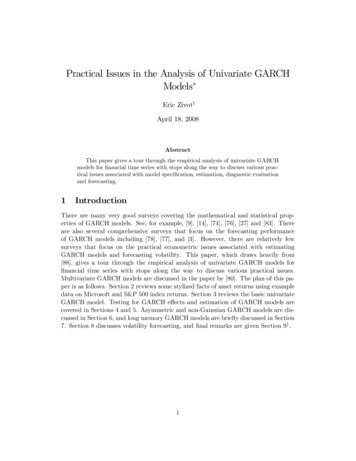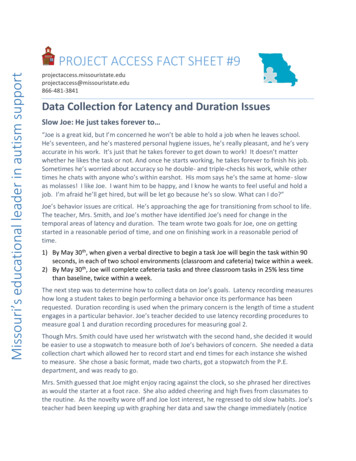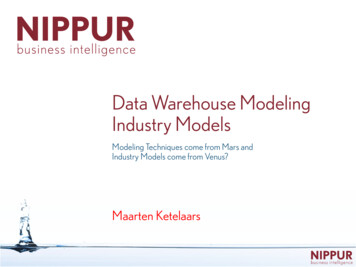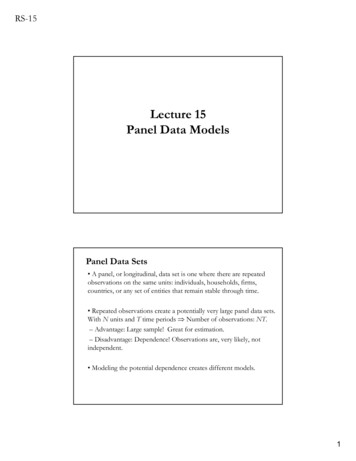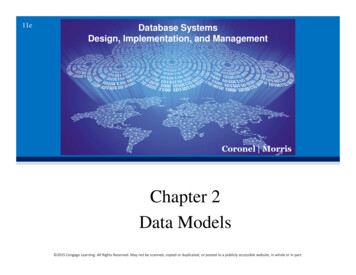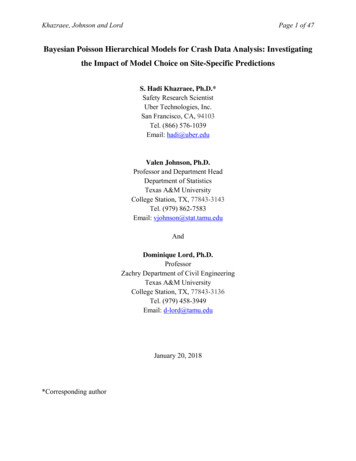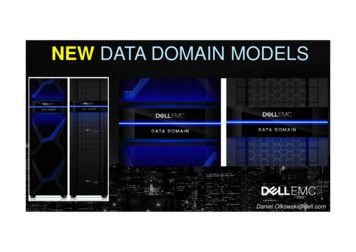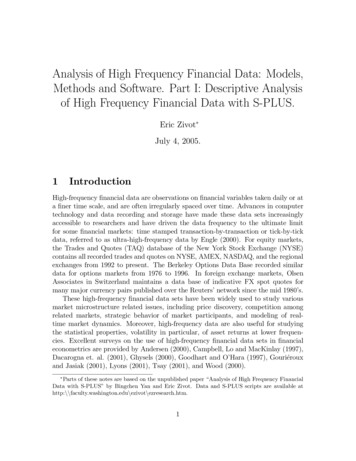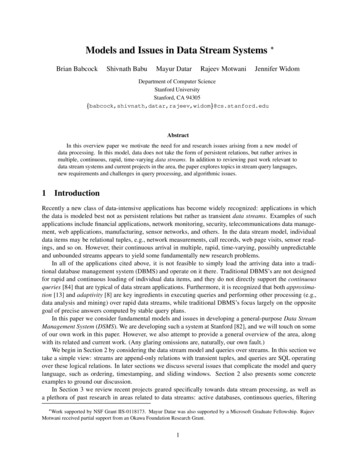
Transcription
Models and Issues in Data Stream SystemsBrian Babcock Shivnath BabuMayur DatarRajeev MotwaniJennifer WidomDepartment of Computer ScienceStanford UniversityStanford, CA 94305babcock,shivnath,datar,rajeev,widom @cs.stanford.eduAbstractIn this overview paper we motivate the need for and research issues arising from a new model ofdata processing. In this model, data does not take the form of persistent relations, but rather arrives inmultiple, continuous, rapid, time-varying data streams. In addition to reviewing past work relevant todata stream systems and current projects in the area, the paper explores topics in stream query languages,new requirements and challenges in query processing, and algorithmic issues.1 IntroductionRecently a new class of data-intensive applications has become widely recognized: applications in whichthe data is modeled best not as persistent relations but rather as transient data streams. Examples of suchapplications include financial applications, network monitoring, security, telecommunications data management, web applications, manufacturing, sensor networks, and others. In the data stream model, individualdata items may be relational tuples, e.g., network measurements, call records, web page visits, sensor readings, and so on. However, their continuous arrival in multiple, rapid, time-varying, possibly unpredictableand unbounded streams appears to yield some fundamentally new research problems.In all of the applications cited above, it is not feasible to simply load the arriving data into a traditional database management system (DBMS) and operate on it there. Traditional DBMS’s are not designedfor rapid and continuous loading of individual data items, and they do not directly support the continuousqueries [84] that are typical of data stream applications. Furthermore, it is recognized that both approximation [13] and adaptivity [8] are key ingredients in executing queries and performing other processing (e.g.,data analysis and mining) over rapid data streams, while traditional DBMS’s focus largely on the oppositegoal of precise answers computed by stable query plans.In this paper we consider fundamental models and issues in developing a general-purpose Data StreamManagement System (DSMS). We are developing such a system at Stanford [82], and we will touch on someof our own work in this paper. However, we also attempt to provide a general overview of the area, alongwith its related and current work. (Any glaring omissions are, naturally, our own fault.)We begin in Section 2 by considering the data stream model and queries over streams. In this section wetake a simple view: streams are append-only relations with transient tuples, and queries are SQL operatingover these logical relations. In later sections we discuss several issues that complicate the model and querylanguage, such as ordering, timestamping, and sliding windows. Section 2 also presents some concreteexamples to ground our discussion.In Section 3 we review recent projects geared specifically towards data stream processing, as well asa plethora of past research in areas related to data streams: active databases, continuous queries, filtering Work supported by NSF Grant IIS-0118173. Mayur Datar was also supported by a Microsoft Graduate Fellowship. RajeevMotwani received partial support from an Okawa Foundation Research Grant.1
systems, view management, sequence databases, and others. Although much of this work clearly has applications to data stream processing, we hope to show in this paper that there are many new problems toaddress in realizing a complete DSMS.Section 4 delves more deeply into the area of query processing, uncovering a number of important issues,including: Queries that require an unbounded amount of memory to evaluate precisely, and approximate queryprocessing techniques to address this problem. Sliding window query processing (i.e., considering “recent” portions of the streams only), both asan approximation technique and as an option in the query language since many applications prefersliding-window queries. Batch processing, sampling, and synopsis structures to handle situations where the flow rate of theinput streams may overwhelm the query processor. The meaning and implementation of blocking operators (e.g., aggregation and sorting) in the presenceof unending streams.Continuous queries that are registered when portions of the data streams have already “passed by,” yetthe queries wish to reference stream history.Section 5 then outlines some details of a query language and an architecture for a DSMS query processordesigned specifically to address the issues above.In Section 6 we review algorithmic results in data stream processing. Our focus is primarily on sketchingtechniques and building summary structures (synopses). We also touch upon sliding window computations,present some negative results, and discuss a few additional algorithmic issues.We conclude in Section 7 with some remarks on the evolution of this new field, and a summary ofdirections for further work.2 The Data Stream ModelIn the data stream model, some or all of the input data that are to be operated on are not available for randomaccess from disk or memory, but rather arrive as one or more continuous data streams. Data streams differfrom the conventional stored relation model in several ways: The data elements in the stream arrive online. The system has no control over the order in which data elements arrive to be processed, either withina data stream or across data streams. Data streams are potentially unbounded in size.Once an element from a data stream has been processed it is discarded or archived — it cannot beretrieved easily unless it is explicitly stored in memory, which typically is small relative to the size ofthe data streams.Operating in the data stream model does not preclude the presence of some data in conventional storedrelations. Often, data stream queries may perform joins between data streams and stored relational data.For the purposes of this paper, we will assume that if stored relations are used, their contents remain static.Thus, we preclude any potential transaction-processing issues that might arise from the presence of updatesto stored relations that occur concurrently with data stream processing.2
2.1 QueriesQueries over continuous data streams have much in common with queries in a traditional database management system. However, there are two important distinctions peculiar to the data stream model. The firstdistinction is between one-time queries and continuous queries [84]. One-time queries (a class that includestraditional DBMS queries) are queries that are evaluated once over a point-in-time snapshot of the data set,with the answer returned to the user. Continuous queries, on the other hand, are evaluated continuously asdata streams continue to arrive. Continuous queries are the more interesting class of data stream queries, andit is to them that we will devote most of our attention. The answer to a continuous query is produced overtime, always reflecting the stream data seen so far. Continuous query answers may be stored and updated asnew data arrives, or they may be produced as data streams themselves. Sometimes one or the other modeis preferred. For example, aggregation queries may involve frequent changes to answer tuples, dictating thestored approach, while join queries are monotonic and may produce rapid, unbounded answers, dictatingthe stream approach.The second distinction is between predefined queries and ad hoc queries. A predefined query is onethat is supplied to the data stream management system before any relevant data has arrived. Predefinedqueries are generally continuous queries, although scheduled one-time queries can also be predefined. Adhoc queries, on the other hand, are issued online after the data streams have already begun. Ad hoc queriescan be either one-time queries or continuous queries. Ad hoc queries complicate the design of a data streammanagement system, both because they are not known in advance for the purposes of query optimization,identification of common subexpressions across queries, etc., and more importantly because the correctanswer to an ad hoc query may require referencing data elements that have already arrived on the datastreams (and potentially have already been discarded). Ad hoc queries are discussed in more detail inSection 4.6.2.2 Motivating ExamplesExamples motivating a data stream system can be found in many application domains including finance,web applications, security, networking, and sensor monitoring. Traderbot [85] is a web-based financial search engine that evaluates queries over real-time streamingfinancial data such as stock tickers and news feeds. The Traderbot web site [85] gives some examplesof one-time and continuous queries that are commonly posed by its customers. Modern security applications often apply sophisticated rules over network packet streams. For example, iPolicy Networks [52] provides an integrated security platform providing services such as firewallsupport and intrusion detection over multi-gigabit network packet streams. Such a platform needs toperform complex stream processing including URL-filtering based on table lookups, and correlationacross multiple network traffic flows. Large web sites monitor web logs (clickstreams) online to enable applications such as personalization, performance monitoring, and load-balancing. Some web sites served by widely distributed webservers (e.g., Yahoo [95]) may need to coordinate many distributed clickstream analyses, e.g., to trackheavily accessed web pages as part of their real-time performance monitoring.There are several emerging applications in the area of sensor monitoring [16, 58] where a large numberof sensors are distributed in the physical world and generate streams of data that need to be combined,monitored, and analyzed.3
The application domain that we use for more detailed examples is network traffic management, whichinvolves monitoring network packet header information across a set of routers to obtain information ontraffic flow patterns. Based on a description of Babu and Widom [10], we delve into this example in somedetail to help illustrate that continuous queries arise naturally in real applications and that conventionalDBMS technology does not adequately support such queries.Consider the network traffic management system of a large network, e.g., the backbone network of anInternet Service Provider (ISP) [30]. Such systems monitor a variety of continuous data streams that may becharacterized as unpredictable and arriving at a high rate, including both packet traces and network performance measurements. Typically, current traffic-management tools either rely on a special-purpose systemthat performs online processing of simple hand-coded continuous queries, or they just log the traffic data andperform periodic offline query processing. Conventional DBMS’s are deemed inadequate to provide the kindof online continuous query processing that would be most beneficial in this domain. A data stream systemthat could provide effective online processing of continuous queries over data streams would allow networkoperators to install, modify, or remove appropriate monitoring queries to support efficient management ofthe ISP’s network resources.Consider the following concrete setting. Network packet traces are being collected from a number oflinks in the network. The focus is on two specific links: a customer link, C, which connects the network ofa customer to the ISP’s network, and a backbone link, B, which connects two routers within the backbonenetwork of the ISP. Let and denote two streams of packet traces corresponding to these two links. Weassume, for simplicity, that the traces contain just the five fields of the packet header that are listed below.src: IP address of packet sender.dest: IP address of packet destination.id: Identification number given by sender so that destination can uniquely identify each packet.len: Length of the packet.time: Time when packet header was recorded.Consider first the continuous query , which computes load on the link B averaged over one-minuteintervals, notifying the network operator when the load crosses a specified threshold . The functions getminute and notifyoperator have the natural interpretation. :SELECTFROMGROUP BYHAVINGnotifyoperator(sum(len)) getminute(time)sum(len)While the functionality of such a query may possibly be achieved in a DBMS via the use of triggers, weare likely to prefer the use of special techniques for performance reasons. For example, consider the casewhere the link B has a very high throughput (e.g., if it were an optical link). In that case, we may choose tocompute an approximate answer to by employing random sampling on the stream — a task outside thereach of standard trigger mechanisms.The second query isolates flows in the backbone link and determines the amount of traffic generatedby each flow. A flow is defined here as a sequence of packets grouped in time, and sent from a specificsource to a specific destination.4
:SELECTFROMGROUP BYflowid, src, dest, sum(len) AS flowlen(SELECTsrc, dest, len, timeFROM ORDER BY time )src, dest, getflowid(src, dest, time)AS flowidHere getflowid is a user-defined function which takes the source IP address, the destination IP address,and the timestamp of a packet, and returns the identifier of the flow to which the packet belongs. We assumethat the data in the view (or table expression) in the FROM clause is passed to the getflowid function inthe order defined by the ORDER BY clause.Observe that handling over stream is particularly challenging due to the presence of GROUP BYand ORDER BY clauses, which lead to “blocking” operators in a query execution plan.Consider now the task of determining the fraction of the backbone link’s traffic that can be attributed tothe customer network. This query, , is an example of the kind of ad hoc continuous queries that may beregistered during periods of congestion to determine whether the customer network is the likely cause. : (SELECTcount (*)FROMC, BWHERE C.src B.src and C.dest B.destand C.id B.id) (SELECT count (*) FROM )Observe that joins streams and on their keys to obtain a count of the number of common packets.Since joining two streams could potentially require unbounded intermediate storage (for example if there isno bound on the delay between a packet showing up on the two links), the user may prefer to compute anapproximate answer. One approximation technique would be to maintain bounded-memory synopses of thetwo streams (see Section 6); alternatively, one could exploit aspects of the application semantics to boundthe required storage (e.g., we may know that joining tuples are very likely to occur within a bounded timewindow).Our final example, , is a continuous query for monitoring the source-destination pairs in the top 5percent in terms of backbone traffic. For ease of exposition, we employ the WITH construct from SQL99 [87]. : WITH Load AS(SELECTsrc, dest, sum(len) AS trafficFROM GROUP BY src, dest)SELECTsrc, dest, trafficFROMLoad AS WHERE(SELECTcount(*)FROMLoad AS WHERE .traffic .traffic) "! count(*) FROM Load)(SELECTORDER BY traffic5
3 Review of Data Stream ProjectsWe now provide an overview of several past and current projects related to data stream management. Wewill revisit some of these projects in later sections when we discuss the issues that we are facing in buildinga general-purpose data stream management system at Stanford.Continuous queries were used in the Tapestry system [84] for content-based filtering over an appendonly database of email and bulletin board messages. A restricted subset of SQL was used as the querylanguage in order to provide guarantees about efficient evaluation and append-only query results. The Alertsystem [74] provides a mechanism for implementing event-condition-action style triggers in a conventionalSQL database, by using continuous queries defined over special append-only active tables. The XFiltercontent-based filtering system [6] performs efficient filtering of XML documents based on user profilesexpressed as continuous queries in the XPath language [94]. Xyleme [67] is a similar content-based filteringsystem that enables very high throughput with a restricted query language. The Tribeca stream databasemanager [83] provides restricted querying capability over network packet streams. The Tangram streamquery processing system [68, 69] uses stream processing techniques to analyze large quantities of storeddata.The OpenCQ [57] and NiagaraCQ [24] systems support continuous queries for monitoring persistentdata sets spread over a wide-area network, e.g., web sites over the Internet. OpenCQ uses a query processing algorithm based on incremental view maintenance, while NiagaraCQ addresses scalability in numberof queries by proposing techniques for grouping continuous queries for efficient evaluation. Within the NiagaraCQ project, Shanmugasundaram et al. [79] discuss the problem of supporting blocking operators inquery plans over data streams, and Viglas and Naughton [89] propose rate-based optimization for queriesover data streams, a new optimization methodology that is based on stream-arrival and data-processing rates.The Chronicle data model [55] introduced append-only ordered sequences of tuples (chronicles), a formof data streams. They defined a restricted view definition language and algebra (chronicle algebra) thatoperates over chronicles together with traditional relations. The focus of the work was to ensure that viewsdefined in chronicle algebra could be maintained incrementally without storing any of the chronicles. Analgebra and a declarative query language for querying ordered relations (sequences) was proposed by Seshadri, Livny, and Ramakrishnan [76, 77, 78]. In many applications, continuous queries need to refer to thesequencing aspect of streams, particularly in the form of sliding windows over streams. Related work in thiscategory also includes work on temporal [80] and time-series databases [31], where the ordering of tuplesimplied by time can be used in querying, indexing, and query optimization.The body of work on materialized views relates to continuous queries, since materialized views areeffectively queries that need to be reevaluated or incrementally updated whenever the base data changes. Ofparticular importance is work on self-maintenance [15, 45, 71]—ensuring that enough data has been saved tomaintain a view even when the base data is unavailable—and the related problem of data expiration [36]—determining when certain base data can be discarded without compromising the ability to maintain a view.Nevertheless, several differences exist between materialized views and continuous queries in the data streamcontext: continuous queries may stream rather than store their results, they may deal with append-only inputdata, they may provide approximate rather than exact answers, and their processing strategy may adapt ascharacteristics of the data streams change.The Telegraph project [8, 47, 58, 59] shares some target applications and basic technical ideas with aDSMS. Telegraph uses an adaptive query engine (based on the Eddy concept [8]) to process queries efficiently in volatile and unpredictable environments (e.g., autonomous data sources over the Internet, or sensornetworks). Madden and Franklin [58] focus on query execution strategies over data streams generated bysensors, and Madden et al. [59] discuss adaptive processing techniques for multiple continuous queries. TheTukwila system [53] also supports adaptive query processing, in order to perform dynamic data integrationover autonomous data sources.6
The Aurora project [16] is building a new data processing system targeted
2 The Data Stream Model In the data stream model, some or all of the input data that are to be operated on are not available for random access from disk or memory, but rather arrive as one or more continuous data streams. Data streams differ from the conventional stored relation model in several ways: The
